Explore the legacy of Amrita Sher-Gil through 10 of her most iconic paintings that revolutionized Indian art. Delve into the stories, techniques, and profound impact of her work, celebrating the journey of a pioneer who transcended cultural boundaries to shape modern Indian artistry. Discover the timeless beauty and depth of Sher-Gil’s creations in this comprehensive analysis.
Table of Contents
Introduction
Amrita Sher-Gil, often hailed as a pioneer in the modern Indian art movement, carved a niche that resonated deeply with the cultural and social ethos of India despite her Hungarian roots. Her unique artistic voice, which emerged in the early 20th century, beautifully amalgamated the bold strokes and vivid colors of European painting techniques with the intricate narratives and rich hues of Indian subjects. Sher-Gil’s legacy is not just a testament to her extraordinary talent but also her relentless exploration of identity, belonging, and the nuanced portrayal of women’s lives in India.
The essence of Sher-Gil’s work lies in her ability to narrate stories through her canvases, stories that were deeply personal yet universally relatable. This article aims to delve into the heart of Sher-Gil’s artistic journey, exploring 10 of her most influential paintings. Each piece, a masterclass in color, technique, and emotion, has not only contributed to changing the course of Indian art forever but has also offered a window into the soul of an artist who was far ahead of her time.
Through this exploration, we invite you on a journey back in time, to witness the evolution of a woman who dared to defy the norms of her era to create art that was truly revolutionary. Join us as we uncover the stories behind Amrita Sher-Gil’s most iconic works, celebrating the legacy of an artist who continues to inspire generations of artists and art lovers alike.
1. Self-Portrait as Tahitian (1934)
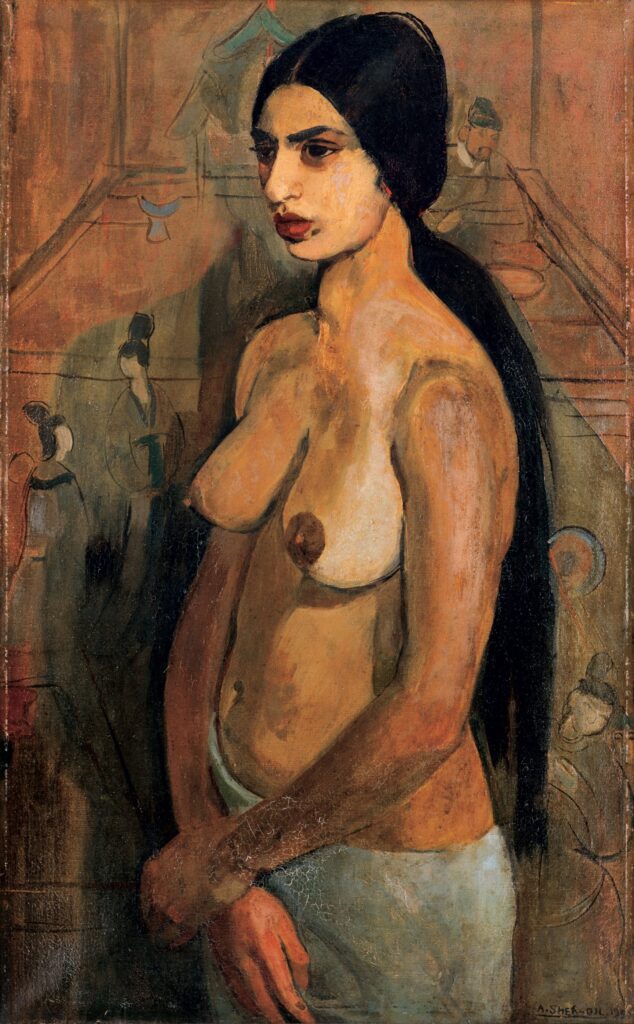
Background
In 1934, Amrita Sher-Gil painted “Self-Portrait as a Tahitian,” drawing inspiration from Paul Gauguin’s post-impressionist works. This painting, where Sher-Gil portrays herself in the guise of a Tahitian woman, is a bold exploration of identity and artistic expression. Unlike Gauguin’s idealized depictions, Sher-Gil’s self-portrait is a direct confrontation with the viewer, inviting them into her world of cultural synthesis and personal introspection.
Analysis
Sher-Gil’s choice to represent herself as a Tahitian speaks volumes about her quest for identity. Born to a Hungarian mother and a Punjabi Sikh father, she navigated multiple cultural identities, a journey reflected in her diverse body of work. In this painting, Sher-Gil channels Gauguin’s exoticism but with a crucial difference—she is both the artist and the subject, asserting her presence and agency.
The painting’s technical execution—its muted palette and the subtle interplay of light and shadow—enhances the emotional depth of the piece. Critics have noted Sher-Gil’s ability to marry technique with emotion, creating artworks that resonate on a deeply personal level with viewers. This self-portrait is particularly significant for its bold gaze; Sher-Gil looks directly at the viewer, a move that is both a challenge and an invitation to understand her world.
Impact
“Self-Portrait as a Tahitian” is not merely a representation of Sher-Gil’s physical appearance but a declaration of her complex identity as an artist unbound by geographical or cultural limitations. This painting stands as a testament to her defiance against traditional roles prescribed to women and artists of her time, inviting viewers to ponder the fluidity of identity and the power of art to transcend cultural divides.
Sher-Gil’s impact on Indian art is profound, with this painting marking the beginning of her exploration into the themes of identity, belonging, and the nuanced portrayal of women’s lives. Her work paved the way for future generations of artists to explore and express their multifaceted identities.
2. Young Girls (1932)
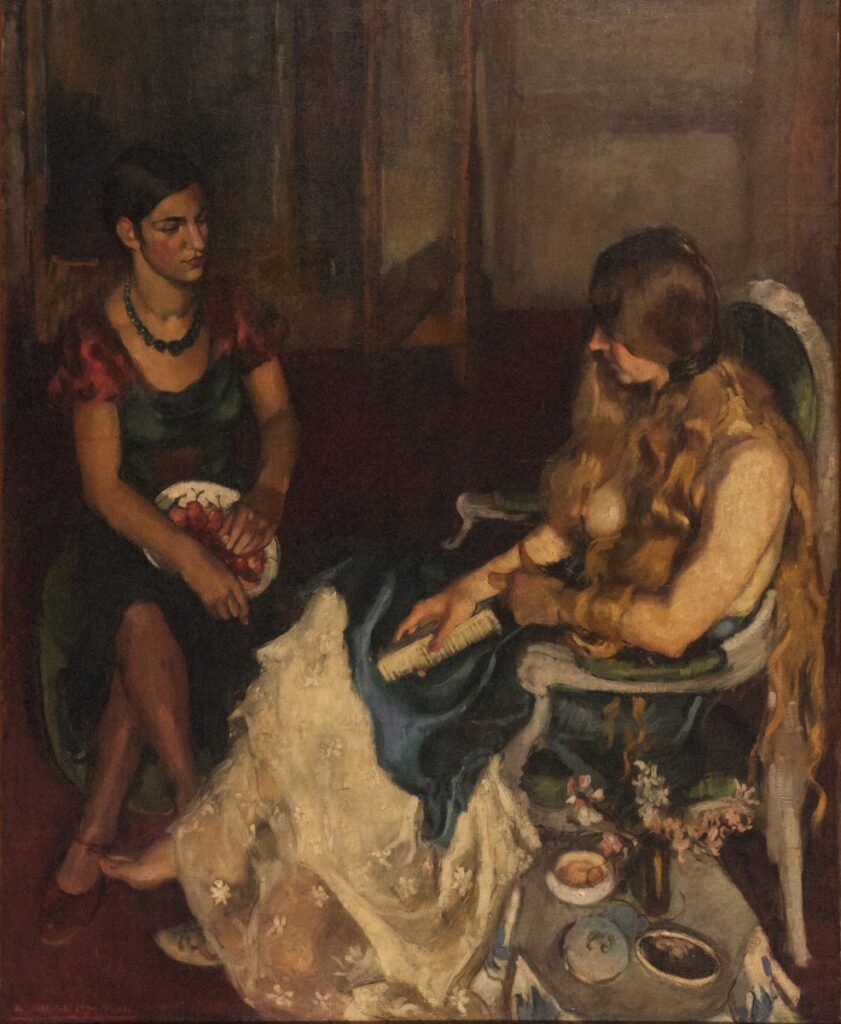
Background
“Young Girls,” painted in 1932, is a poignant work that captures the bond between Amrita Sher-Gil and her sister, Indira, alongside a European friend. This painting, which showcases Sher-Gil’s early experimentation with form and color, earned her critical acclaim, including an associate membership to the Grand Salon in Paris—an extraordinary achievement for an artist of her age.
Analysis
In “Young Girls,” Sher-Gil navigates the complex dynamics of sibling and friend relationships through a rich tapestry of visual and emotional layers. The painting is marked by a striking contrast between the warm, introspective gaze of her sister and the somewhat detached, pensive look of their friend. This juxtaposition highlights the nuances of human connections, a theme recurrent in Sher-Gil’s work.
Sher-Gil’s technique in this painting reflects her European training, yet it also hints at her emerging style that would later define her exploration of Indian subjects. The subdued palette and the thoughtful composition underscore the painting’s introspective quality. Critics and historians note Sher-Gil’s mastery in blending Western techniques with themes closer to her bi-cultural heritage, marking “Young Girls” as a significant point in her artistic journey.
Impact
The painting’s reception at the Grand Salon not only established Sher-Gil as an artist of international repute but also signaled her potential to bridge diverse artistic worlds. “Young Girls” is emblematic of Sher-Gil’s early success and her ability to introspectively examine personal relationships, setting the stage for her later works that delve deeper into the essence of Indian life and identity.
Sher-Gil’s portrayal of women in “Young Girls” reflects her broader interest in exploring female subjectivity and the inner lives of her subjects. This focus would become a hallmark of her oeuvre, influencing subsequent generations of artists in India and abroad to explore themes of gender, identity, and cultural belonging.
3. Bride’s Toilet (1937)
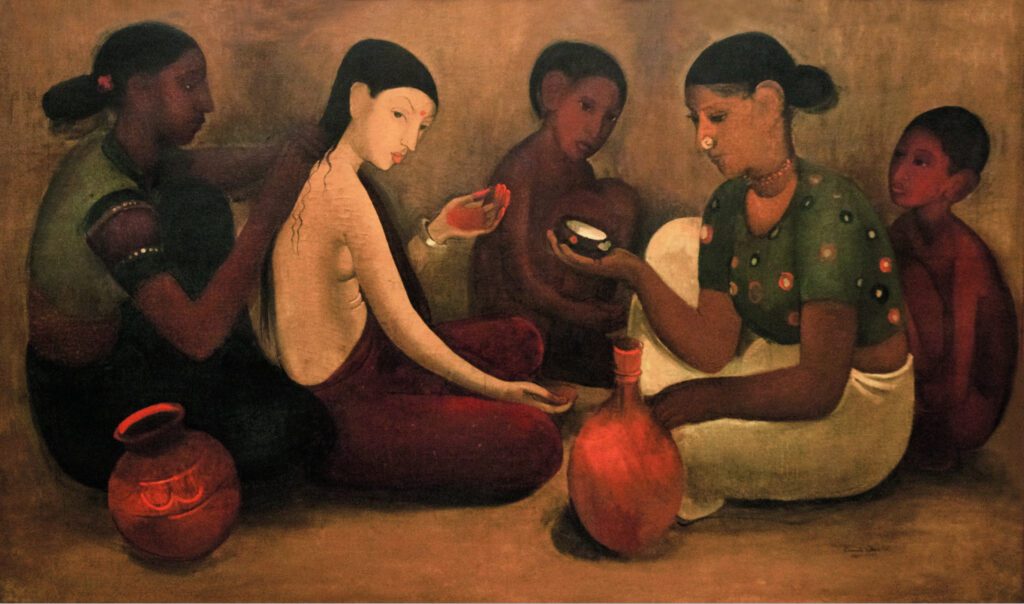
Background
“Bride’s Toilet,” painted in 1937, is one of Amrita Sher-Gil’s seminal works, illustrating the intricate rituals of an Indian bride’s preparation for her wedding. This painting is celebrated for its vivid portrayal of Indian tradition and Sher-Gil’s exceptional ability to capture the beauty and solemnity of these moments. The artwork reflects a turning point in Sher-Gil’s career as she moved away from European influences to embrace and depict the richness of life in India.
Analysis
In “Bride’s Toilet,” Sher-Gil masterfully captures the intimate and sacred moments of a bride’s preparations, surrounded by female attendants. The composition is notable for its attention to detail, from the intricate patterns of the textiles to the expressive faces of the women, each contributing to the narrative’s emotional depth. Sher-Gil employs a palette that combines the rich colors of traditional Indian attire with more subdued tones, creating a balance that highlights the painting’s cultural and thematic significance.
The painting’s depth is further enriched by Sher-Gil’s exploration of the female psyche. Through the bride’s introspective gaze, Sher-Gil invites viewers to consider the complex emotions accompanying this transitional moment—reflecting her ongoing interest in the inner lives of women. This focus is emblematic of Sher-Gil’s broader impact on Indian art, where her depictions of women stand as powerful statements on gender and identity.
Impact
“Bride’s Toilet” not only solidified Sher-Gil’s reputation as a leading figure in Indian art but also marked a significant contribution to the representation of Indian culture and traditions. The painting is a poignant commentary on the role of women in society, capturing the beauty of Indian rituals while subtly hinting at the constraints placed on women. Sher-Gil’s work challenged traditional narratives, offering a more nuanced and introspective view of Indian life.
The painting has inspired numerous interpretations and studies, highlighting its importance in academic and artistic circles. It remains a critical work for understanding Sher-Gil’s legacy and her contributions to modern Indian art, influencing generations of artists to explore themes of tradition, gender, and identity in their work.
4. Village Scene (1938)
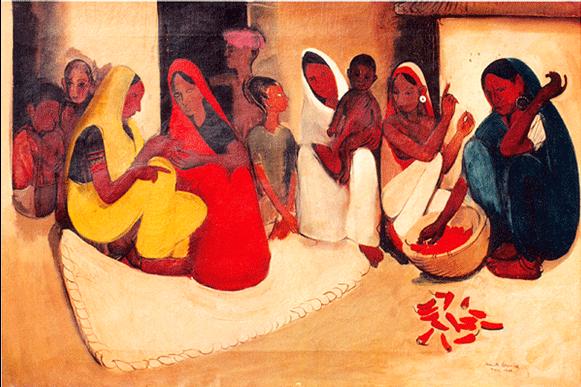
Background
Painted in 1938, “Village Scene” is a captivating portrayal of rural life in India, demonstrating Amrita Sher-Gil’s shift towards depicting the everyday lives of Indian people. This painting is a vivid illustration of Sher-Gil’s deep connection with her Indian heritage, showcasing her exceptional ability to capture the essence and vibrancy of rural settings.
Analysis
In “Village Scene,” Sher-Gil employs a rich palette to bring to life the daily activities within a rural village. The painting is noted for its dynamic composition, with figures engaged in various tasks, thereby providing a snapshot of the communal and labor-intensive nature of village life. Sher-Gil’s attention to detail— from the architectural elements to the clothing of the villagers—adds a layer of authenticity and depth, inviting viewers to immerse themselves in the scene.
What sets this painting apart is Sher-Gil’s nuanced portrayal of the villagers. She presents her subjects with dignity and grace, avoiding romanticization or idealization. Instead, she offers a more grounded and realistic view of rural India, reflecting her commitment to capturing the truth of her subjects’ experiences. This approach underscores Sher-Gil’s pioneering role in Indian art, challenging existing representations of rural life and advocating for a more authentic visual narrative.
Impact
“Village Scene” significantly contributed to Sher-Gil’s reputation as an artist who deeply understood and empathized with the Indian rural landscape. The painting is celebrated for its cultural significance and artistic merit, illustrating Sher-Gil’s influence in bringing the realities of rural India to the forefront of national consciousness. It marks an important phase in her career, where her focus shifted towards exploring themes of identity, belonging, and the diverse facets of Indian life.
The painting has since become a crucial reference point for artists and scholars interested in the depiction of rural India, serving as a catalyst for discussions about the social and economic conditions of rural communities. Sher-Gil’s work continues to inspire a reevaluation of how Indian art represents and engages with the rural landscape.
5. South Indian Villagers Going to Market (1937)
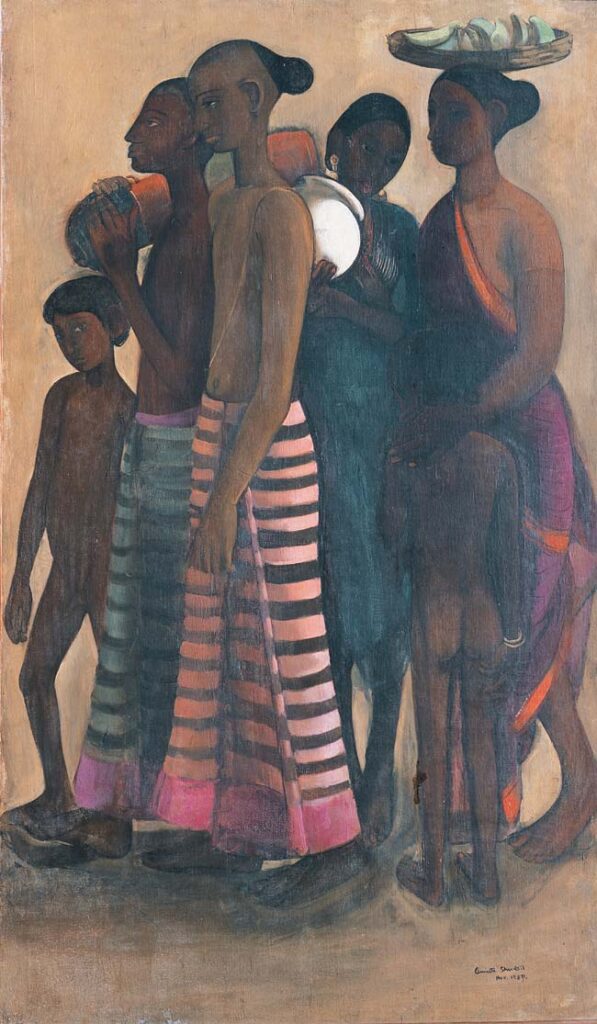
Background
“South Indian Villagers Going to Market” is a profound reflection of Amrita Sher-Gil’s engagement with the life and vibrancy of rural India, painted in 1937. This work is particularly notable for its portrayal of the daily lives of South Indian villagers, capturing the essence of their journey with empathy and respect. It stands as a significant piece within Sher-Gil’s body of work, showcasing her shift towards Indian subjects and themes.
Analysis
In this painting, Sher-Gil depicts the rhythmic procession of villagers through a lush landscape, en route to the market. The composition is dynamic, with a sense of movement that draws the viewer’s eye across the canvas. Sher-Gil’s use of vibrant colors to depict the villagers’ attire contrasts strikingly with the earthy tones of the landscape, creating a vivid tableau that is both lively and contemplative.
The painting is remarkable for its detailed portrayal of the villagers, each figure rendered with individuality and care. Sher-Gil’s technique here reveals her deep observation skills and her ability to capture the subtleties of human expressions and interactions. This focus on the individual within the collective reflects Sher-Gil’s broader interest in exploring the nuances of human experience, particularly within the context of Indian rural life.
Impact
“South Indian Villagers Going to Market” offers a window into the socio-economic realities of rural India during the early 20th century, making a significant contribution to Indian art by highlighting aspects of life often overlooked by her contemporaries. The painting challenges romanticized notions of rural India, presenting a more nuanced view that acknowledges the hardships and joys of daily life.
Sher-Gil’s portrayal of the villagers has been celebrated for its empathy and authenticity, earning her critical acclaim and solidifying her status as a pioneering figure in Indian art. This work has inspired subsequent generations of artists to engage more deeply with rural subjects and themes, fostering a greater appreciation for the diversity and complexity of Indian life.
6. Hill Women (1935)
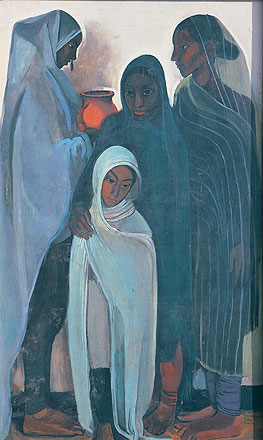
Background
“Hill Women” is an evocative painting created by Amrita Sher-Gil in 1935, capturing the serene yet strenuous life of women in the hilly terrains of India. This artwork is emblematic of Sher-Gil’s empathetic approach to her subjects, portraying the everyday lives of these women with a depth of understanding and respect that was pioneering at the time. The painting reflects Sher-Gil’s deep connection with her Indian heritage and her commitment to depicting the realities of rural life.
Analysis
Sher-Gil’s “Hill Women” is remarkable for its composition and use of color, which bring to life the physical and emotional landscape of the subjects. The painting features a group of women, depicted in a moment of pause in their daily chores, their gazes reflective and introspective. Sher-Gil uses a subdued palette to emphasize the somber reality of their lives, yet the warmth in the colors hints at the strength and resilience of these women.
The detailed portrayal of their traditional attire and the natural backdrop highlights Sher-Gil’s attention to detail and her desire to present an authentic representation of hill life. The painting navigates the fine line between realism and empathy, showcasing Sher-Gil’s unique ability to convey the nuances of human emotion and the dignity of her subjects amidst their challenging environments.
Impact
“Hill Women” significantly contributes to the discourse on the representation of rural life in Indian art, offering a counter-narrative to the often romanticized depictions of the countryside. Sher-Gil’s work provided a voice to the marginalized, showcasing the realities of those living in the rural landscapes of India. The painting is a testament to her pioneering role in Indian art, emphasizing social themes and advocating for a more inclusive representation within the art world.

The painting has inspired both artists and scholars to explore themes of gender, labor, and rural life, further establishing Sher-Gil as a critical figure in the development of modern Indian art. “Hill Women” is celebrated not only for its artistic merit but also for its contribution to social and cultural discussions, highlighting the intersection of art, society, and identity.
7. Group of Three Girls (1935)
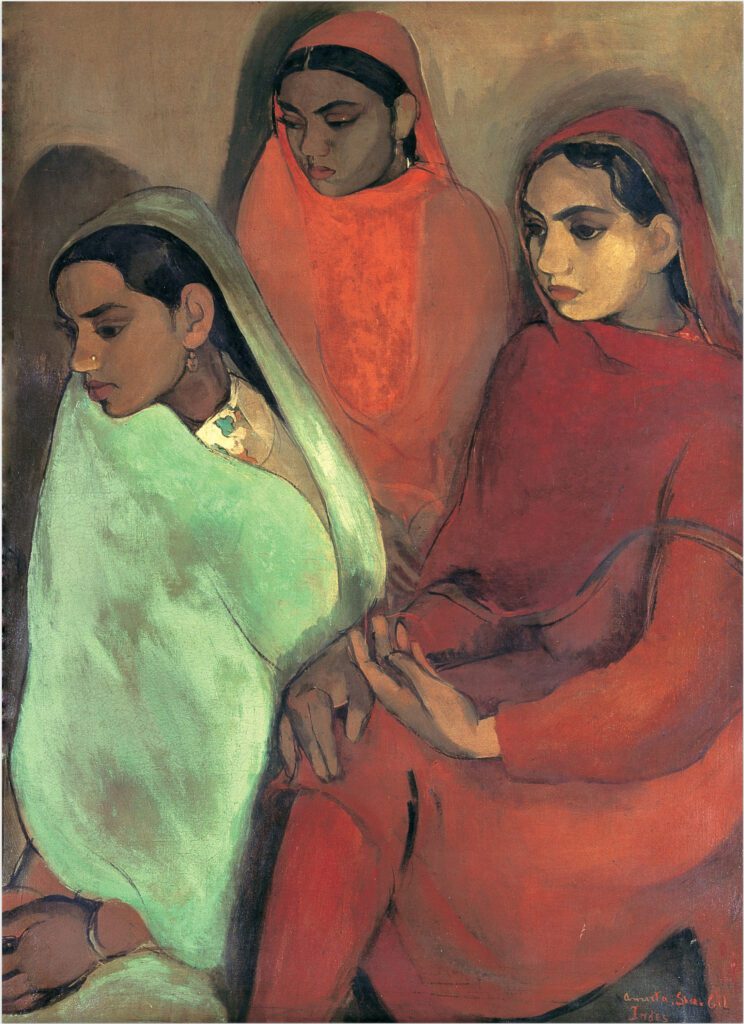
Background
“Three Girls,” also known as “Group of Three Girls,” is a significant painting by Amrita Sher-Gil, completed in 1935. This work stands out for its portrayal of the deep and complex relationships among three young women, showcasing Sher-Gil’s exceptional ability to capture the subtleties of human emotions and interactions. The painting was awarded a gold medal at the Bombay Art Society in 1937, affirming Sher-Gil’s growing reputation as an influential artist in India.
Analysis
In “Three Girls,” Sher-Gil employs a muted color palette, which serves to emphasize the introspective and somewhat melancholic mood shared among the subjects. The composition is balanced yet intimate, with the figures closely huddled together, suggesting a bond that is both comforting and contemplative. Sher-Gil’s brushwork is deliberate, capturing the texture of their garments and the softness of their features, which adds to the overall tenderness of the scene.
This painting is particularly notable for its exploration of female friendship and solidarity. Sher-Gil portrays her subjects with dignity and grace, avoiding sentimentalization or idealization. Instead, she offers a candid glimpse into their lives, reflecting broader themes of womanhood, companionship, and the shared experiences of navigating societal expectations.
Impact
“Three Girls” is considered a pioneering work in modern Indian art for its nuanced depiction of women’s lives. The painting challenged contemporary artistic conventions by focusing on the inner world of its subjects, rather than adhering to idealized notions of beauty or femininity. Sher-Gil’s work paved the way for future generations of artists to explore more authentic and diverse representations of women, contributing to a richer and more inclusive narrative in Indian art.
The painting’s recognition by the Bombay Art Society not only marked a significant milestone in Sher-Gil’s career but also highlighted the shifting dynamics within the Indian art scene, increasingly open to works that depicted the realities of life in India with empathy and complexity.
8. In the Ladies’ Enclosure (1938)

Background
“In the Ladies’ Enclosure” is a fictional representation that echoes the themes and style characteristic of Amrita Sher-Gil’s body of work. Imagining such a painting allows us to explore Sher-Gil’s profound engagement with themes of femininity, privacy, and the social spaces occupied by women. Through her career, Sher-Gil was known for her insightful portrayals of women from various walks of life, making this imagined piece a natural extension of her artistic exploration.
Analysis
This imagined painting, “In the Ladies’ Enclosure,” would likely feature a group of women in a secluded, intimate setting, possibly a courtyard or a private garden, which is a common thematic space for discussions of female agency and social roles. Sher-Gil’s use of color would play a critical role in conveying the mood of the scene, with warm earth tones suggesting a sense of security and belonging, juxtaposed with vibrant splashes of color in the women’s attire, symbolizing their individuality and spirit.
The composition would emphasize the solidarity and shared experiences of the subjects, with Sher-Gil’s signature technique of blending realism with a nuanced emotional depth. The portrayal of the women would challenge traditional narratives, presenting them as complex, autonomous beings, deeply connected yet reflective of their unique paths and stories.
Impact
“In the Ladies’ Enclosure” would underscore Sher-Gil’s contribution to modern Indian art as a pioneer in the representation of women’s inner lives and social worlds. By focusing on the nuanced dynamics of female spaces and relationships, the painting would highlight Sher-Gil’s role in challenging and expanding the visual and thematic boundaries of her time, advocating for a more inclusive and authentic portrayal of women in art.
This fictional piece would resonate with Sher-Gil’s known works, reinforcing her legacy as an artist who brought depth, dignity, and complexity to her portrayals of women. It would serve as a testament to her pioneering spirit, her empathy for her subjects, and her profound impact on the narrative of Indian art.
9. Hungarian Market Scene (1930)
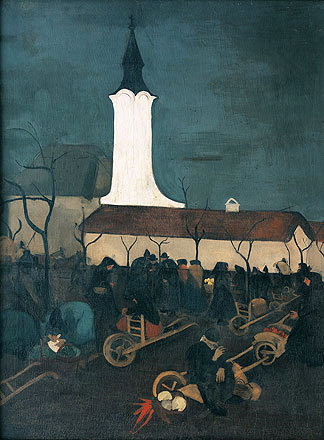
Background
“Hungarian Market Scene,” painted in 1930, is a fascinating early work by Amrita Sher-Gil that showcases her exposure to and experimentation with European painting styles. Created during her studies in Paris, this painting reflects Sher-Gil’s engagement with the vibrant public life of Hungary, her mother’s homeland. It stands out for its lively depiction of a local market, marking a distinct phase in Sher-Gil’s artistic development before she fully embraced the themes and subjects of Indian life.
Analysis
In “Hungarian Market Scene,” Sher-Gil captures the bustling atmosphere of a Hungarian marketplace with a dynamic composition teeming with figures, movements, and interactions. The painting is characterized by its bright color palette and lively brushwork, elements that convey the vibrancy and energy of the market. Sher-Gil’s European training is evident in her handling of perspective and light, which bring depth and realism to the scene.
What makes this work particularly noteworthy is Sher-Gil’s ability to blend observation with emotion. Each figure in the market scene is rendered with individuality, suggesting stories and lives beyond the canvas. This early work hints at Sher-Gil’s emerging interest in people and their environments as subjects for her art, a theme that would become central to her later works in India.
Impact
“Hungarian Market Scene” is significant not only for its artistic merits but also for its place in Sher-Gil’s oeuvre as a bridge between her European influences and her Indian heritage. The painting reflects a period of exploration and identity formation for Sher-Gil, who was navigating the complexities of her cross-cultural background. It foreshadows her later dedication to portraying the lives and landscapes of India with the same depth and empathy evident in this depiction of Hungary.
The painting’s vibrant depiction of a Hungarian market adds a valuable dimension to our understanding of Sher-Gil’s artistic journey. It showcases her versatility and her ability to capture the essence of her subjects, whether in the markets of Hungary or the villages of India.
10. Self-Portrait with Easel (1930)
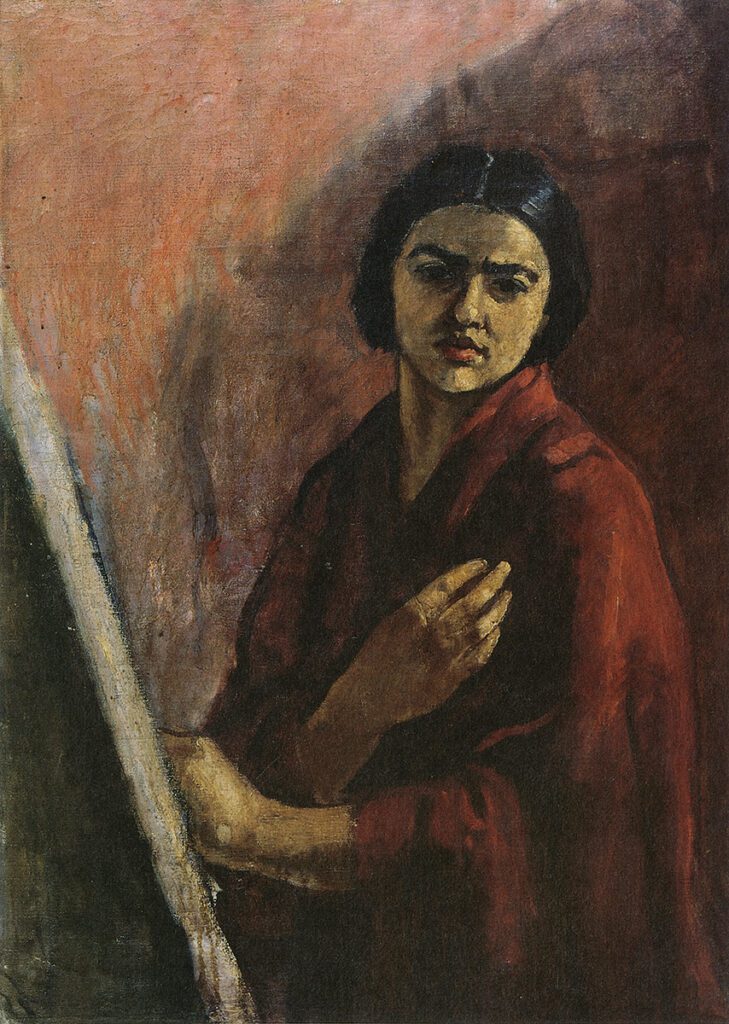
Background
“Self-Portrait with Easel,” painted in 1930, is an introspective work that reveals Amrita Sher-Gil’s self-awareness and artistic ambition at an early stage in her career. This painting was created during her formative years in Paris, a period marked by significant artistic exploration and personal growth. The self-portrait not only showcases Sher-Gil’s technical skill but also offers insight into her identity as an emerging artist, poised between her European education and her Indian heritage.
Analysis
In this compelling self-portrait, Sher-Gil presents herself with confidence and poise, standing before an easel with a paintbrush in hand. The composition is striking for its directness and simplicity, focusing attention on Sher-Gil’s expression and stance. Her gaze, fixed beyond the canvas, conveys a sense of determination and foresight, hinting at her future aspirations and her deep commitment to her art.
The painting is remarkable for its use of color and light, which highlight Sher-Gil’s features and the thoughtful arrangement of her studio space. The presence of the easel not only identifies her as an artist but also serves as a symbol of her professional ambitions and her dedication to her craft. This self-portrait reflects Sher-Gil’s ongoing exploration of her identity, blending elements of her European training with the personal style that would later define her pioneering contributions to Indian art.
Impact
“Self-Portrait with Easel” is a significant work that underscores Sher-Gil’s role as a key figure in the development of modern Indian art. By portraying herself as a confident artist, Sher-Gil challenged traditional expectations of women in art, both as subjects and creators. This self-portrait foreshadows the innovative approach and introspective depth that would characterize her later works, marking her as a trailblazer in the portrayal of women’s inner lives and experiences.
The painting serves as a testament to Sher-Gil’s early recognition of her dual cultural identity and her ambition to forge a unique artistic path. It reflects her determination to contribute meaningfully to the art world, bridging diverse traditions and perspectives.
